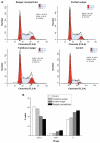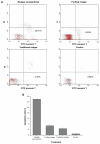Preparation and characterization of realgar nanoparticles and their inhibitory effect on rat glioma cells
- PMID: 22238507
- PMCID: PMC3254263
- DOI: 10.2147/IJN.S26237
Preparation and characterization of realgar nanoparticles and their inhibitory effect on rat glioma cells
Abstract
Aim: Our objective was to prepare a new nano-sized realgar particle and characterize its anti-tumor effect on tumor cells.
Methods: Nanoparticles were prepared by coprecipitation and were detected by transmission electron microscopy, scanning electron microscopy, energy dispersive spectrometry (EDS), and dynamic light scattering. An anti-proliferative effect of realgar nanoparticles on rat glioma (C6) cells was determined by the MTT assay. Cell cycle and apoptosis rates were observed by flow cytometry. Apoptosis-related gene expression was detected by immunofluorescence staining.
Results: Realgar nanoparticles were successfully prepared. The particles were spherical, with an average diameter of approximately 80 nm, and contained arsenic and sulfur elements. Realgar nanoparticles inhibited C6 cell proliferation and induced apoptosis in a dose- and time-dependent manner. Treatment of C6 cells with realgar nanoparticles significantly increased the proportions of cells in S and G2/M phases, decreased the proportion of cells in G0/G1 phase, downregulated Bcl-2 expression, and substantially upregulated Bax expression.
Conclusion: Realgar nanoparticles significantly inhibited C6 glioma cell proliferation and promoted cell apoptosis by inducing the upregulation of Bax and downregulation of Bcl-2 expression. Realgar nanoparticles are a promising in vitro anti-cancer strategy and may be applicable for human cancer therapy studies.
Keywords: characterization; inhibitory effect; preparation; realgar.
Figures







References
-
- Jing Y, Aoki H, Kakinuma K, et al. Therapeutic efficacy of targeting chemotherapy using local hyperthermia and thermosensitive liposome: evaluation of drug distribution in a rat glioma model. Int J Hyperthermia. 2004;20(6):595–605. - PubMed
-
- Zhao QH, Zhang Y, Liu Y, et al. Anticancer effect of realgar nanoparticles on mouse melanoma skin cancer in vivo via transdermal drug delivery. Med Oncol. 2010;27(2):203–212. - PubMed
-
- Wang XB, Gao HY, Hou BL, Huang J, Xi RG, Wu LJ. Nanoparticle realgar powders induce apoptosis in U937 cells through caspase MAPK and mitochondrial pathways. Arch Pharm Res. 2007;30(5):653–658. - PubMed
-
- Baláž P, Fabián M, Pastorek M, Cholujová D, Sedlák J. Mechanochemical preparation and anticancer effect of realgar (As4S4) nanoparticle. Mater Lett. 2009;63(17):1542–1544.
Publication types
MeSH terms
Substances
LinkOut - more resources
Full Text Sources
Research Materials

